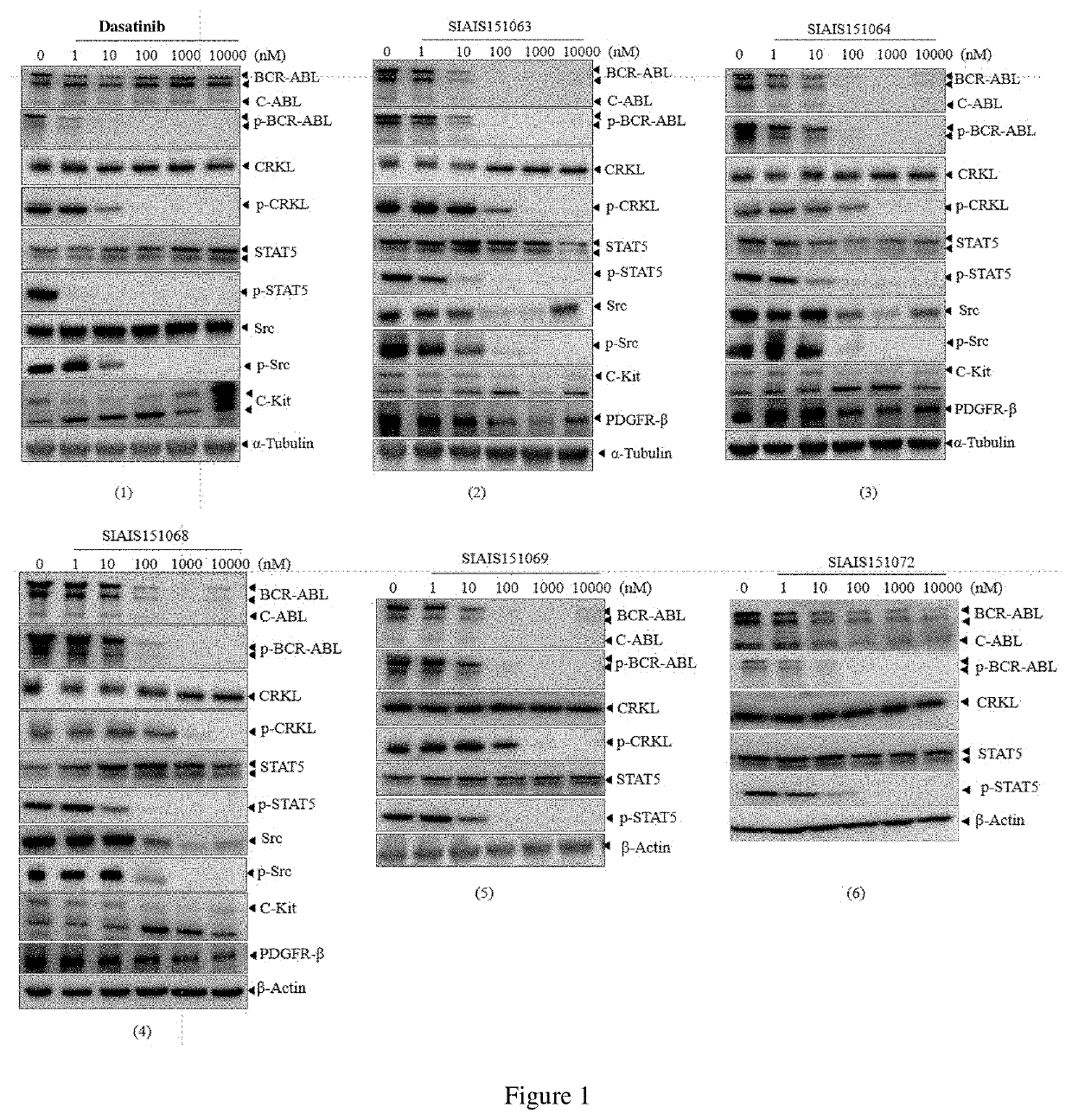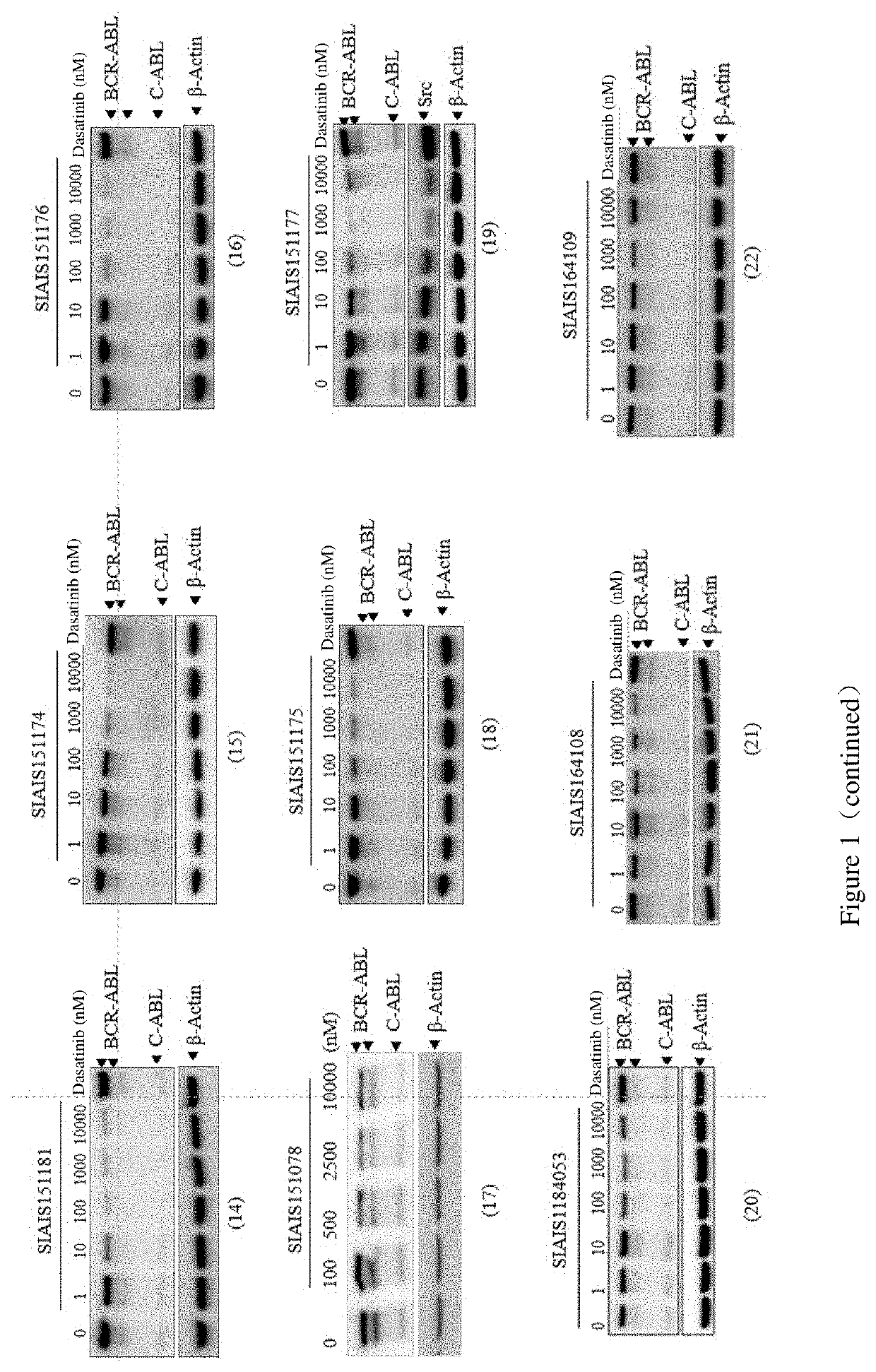Compounds targeting and degrading bcr-abl protein and its antitumor application
a technology of bcr-abl and fusion protein, which is applied in the direction of peptides/proteins, drug compositions, peptides, etc., can solve the problems of not fundamentally eliminating the pathogenic bcr-abl gene, poor response and side effects of traditional treatment based on interferon or chemotherapy, and unable to achieve the effect of genetics or molecular biology relief for patients
- Summary
- Abstract
- Description
- Claims
- Application Information
AI Technical Summary
Benefits of technology
Problems solved by technology
Method used
Image
Examples
example 1
Intermediate Preparation of Dasatinib Analog
[0155]
Preparation of N-(2-chloro-6-methylphenyl)-2-((2-methyl-6-(piperazin-1-yl)pyrimidin 4-yl)amino)thiazole-5-carboxamide (SIAIS151055) Based on Scheme 1
[0156]In a 30 mL microwave reaction tube, to a stirred solution of 2-((6-chloro-2-methylpyrimidin-4-yl)amino)-N-(2-chloro-6-methylphenyl)thiazole-5-carboxamide (1.0 g, 2.54 mmol), anhydrous piperazine (1.31 g, 15.21 mmol) and N,N-diisopropylethylamine (4.9 g, 38.0 mmol) was added n-BuOH (8 mL), the mixture was filled with Ar and stirring for 10 minutes at room temperature, then it was heated to 120° C. in microwave reactor and stirring for another 1 h. The reaction mixture was then cooled to room temperature, a large amount of white solid was formed, filtered, washed by n-BuOH, and concentrated under reduced pressure to afford compound SIAIS151055 as a white solid (0.9 g, 80% yield). 1H NMR (500 MHz, DMSO) δ 9.88 (s, 1H), 8.23 (s, 1H), 7.43-7.38 (m, 1H), 7.31-7.24 (m, 2H), 6.04 (s, 1H),...
preparation examples
Example 1: Preparation of N-(2-chloro-6-methylphenyl)-2-((6-(4-(3-(2-((2-(2,6-dioxopiperidin-3-yl)-1,3-dioxoisoindolin-4-yl)amino)ethoxy)propanoyl)piperazin-1-yl)-2-methylpyrimidin-4-yl)amino)thiazole-5-carboxamide (SIAIS151063)
[0239]Based on the general method of scheme 19 as described herein, compound (SIAIS151063) was obtained by coupling reaction of (SIAIS151055) with HO2C-LIN-ULM analog (SIAIS151001) as a yellow solid (30.2 mg, 82% yield). 1H NMR (500 MHz, MeOD) δ 8.21 (s, 1H), 7.55-7.47 (m, 1H), 7.37 (dd, J=7.5, 1.5 Hz, 1H), 7.30-7.21 (m, 2H), 7.04 (d, J=8.5 Hz, 1H), 6.95 (d, J=7.1 Hz, 1H), 6.13 (s, 1H), 5.02 (dd, J=12.8, 5.4 Hz, 1H), 3.84 (t, J=5.8 Hz, 2H), 3.79-3.62 (m, 10H), 3.52-3.45 (m, 2H), 2.87-2.79 (m, 1H), 2.77-2.61 (m, 4H), 2.54 (s, 3H), 2.33 (s, 3H), 2.13-2.05 (m, 1H). HRMS (ESI) m / z: calcd C38H40ClN10O7S+ [M+H]+, 815.2485; found, 815.3241.
example 2
on of N-(2-chloro-6-methylphenyl)-2-((6-(4-(3-(2-(2-((2-(2,6-dioxopiperidin-3-yl)-1,3-dioxoisoindolin-4-yl)amino)ethoxy)ethoxy)propanoyl)piperazin-1-yl)-2-methylpyrimidin-4-yl)amino)thiazole-5-carboxamide (SIAIS151064)
[0240]Based on the general method of scheme 19 as described herein, compound (SIAIS151064) was obtained by coupling reaction of (SIAIS151055) with HO2C-LIN-ULM analog (SIAIS151004) as a yellow solid (13.7 mg, 35% yield). 1H NMR (500 MHz, MeOD) δ 8.18 (s, 1H), 7.49-7.43 (m, 1H), 7.38-7.34 (m, 1H), 7.29-7.21 (m, 2H), 6.97 (d, J=8.6 Hz, 1H), 6.92 (d, J=7.1 Hz, 1H), 6.09 (s, 1H), 5.05 (dd, J=12.7, 5.5 Hz, 1H), 3.79 (t, J=5.8 Hz, 4H), 3.70 (dd, J=11.6, 6.3 Hz, 6H), 3.64 (t, J=3.8 Hz, 6H), 3.42 (t, J=5.2 Hz, 2H), 2.89-2.79 (m, 1H), 2.78-2.65 (m, 4H), 2.50 (s, 3H), 2.33 (s, 3H), 2.15-2.09 (m, 1H). HRMS (ESI) m / z: calcd C40H44ClN10O8S+ [M+H]+, 859.2747; found, 859.3538.
PUM
| Property | Measurement | Unit |
|---|---|---|
| temperature | aaaaa | aaaaa |
| temperature | aaaaa | aaaaa |
| temperature | aaaaa | aaaaa |
Abstract
Description
Claims
Application Information
 Login to View More
Login to View More - R&D
- Intellectual Property
- Life Sciences
- Materials
- Tech Scout
- Unparalleled Data Quality
- Higher Quality Content
- 60% Fewer Hallucinations
Browse by: Latest US Patents, China's latest patents, Technical Efficacy Thesaurus, Application Domain, Technology Topic, Popular Technical Reports.
© 2025 PatSnap. All rights reserved.Legal|Privacy policy|Modern Slavery Act Transparency Statement|Sitemap|About US| Contact US: help@patsnap.com



